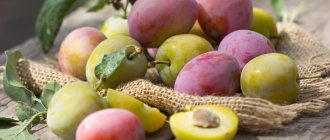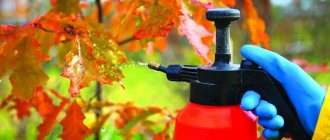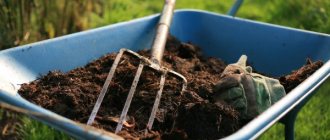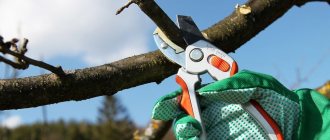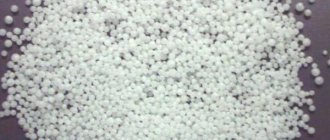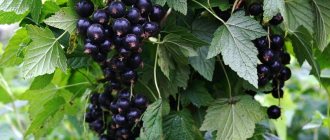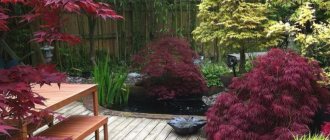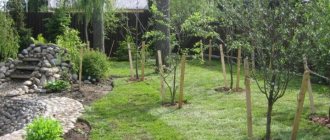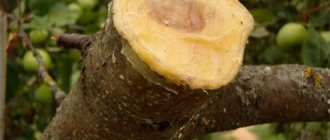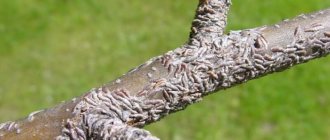- Feeding fruit trees and shrubs in autumn
- The importance of autumn fertilizers for fruit trees
- Timing for autumn feeding of fruit trees and shrubs
- How to fertilize fruit trees before winter
- Mineral autumn fertilizing in September and October
- Phosphorus compounds for fruit trees
- Good potash fertilizers
- Combined fertilizers to increase yield
- Vegetable ash for garden autumn feeding
- How to feed shrubs with organic matter in the garden
- Liquid feeding of garden trees in autumn
- Video: how and with what to fertilize fruit trees correctly
Feeding fruit trees and shrubs in autumn
In autumn, active preparation for winter begins in all gardens, in all areas. Gardeners still have a lot of work to do, and one of the important tasks is feeding fruit trees in the fall . We will discuss below what fertilizers, how, when and in what quantities should be applied to fruit trees and shrubs in the fall.
In order to enjoy the lush flowering of the garden in the spring and collect ripe fruits at the end of summer, special attention should be paid to fertilizing in the fall.
Organic
The possibility of increasing the thickness of the fertile layer is provided by autumn fertilizing of fruit trees with organic substances. How does this happen:
- Nutrients enter the soil, where soil bacteria and earthworms begin to eat them.
- Due to rain, unprocessed residues sink to the lower layers. Accordingly, microorganisms move deep into the soil for food, where they leave the products of their vital activity.
The more organic matter in the soil, the better it holds moisture and the more nutritious it is for plants.
What to use and how to fertilize fruit trees in the fall:
- wood ash;
- manure, humus;
- chicken droppings;
- compost;
- green manure.
Wood ash is considered an autumn fertilizer for fruit trees and bushes.
There is no nitrogen in it, only potassium, phosphorus and calcium. This is all that fruit trees are fed with in August-September. In addition to the main nutrients, plant residues contain microdoses of substances that affect the plant’s immunity: boron, zinc, copper, iron, magnesium, manganese and others.
In order to stock up on a sufficient amount of ash, it is necessary to collect it after burning leaves, branches, unnecessary bark and store it in a dry place, protected from moisture. To properly apply ash fertilizer and ensure uptake by trees, you must first water the soil. But autumn watering is not 2 - 3 buckets. Depending on the age of the tree and the size of its crown, it may take 200 - 250 liters of water for each tree. To ensure that water is well absorbed and does not spill over the area, the soil around the trunk is dug up. At the same time, add ash - 200 g per square meter. This is followed by abundant watering and mulching, which reduces evaporation and warms the tree roots. It is especially useful for autumn feeding of young, newly transplanted plants.
Feeding fruit trees in the fall is done with rotted manure.
- Fresh is not used either in the autumn or in the spring.
- It contains a lot of active ammonia, which will damage tree roots and destroy seedlings in a matter of days.
- Manure used in the garden is one or two years old.
- It is not recommended to keep it any longer, as the substance loses its beneficial properties. The manure is evenly distributed around the tree trunk and dug up to a depth of 30 cm, then watered with plenty of water, as already described.
- About 6 kg of manure is needed per square meter.
Chicken droppings
You can make a solution: fill a third of a bucket of droppings with water and leave for a week. Dig up the tree trunk circle, pour out the solution and pour water on top. Bird droppings are more nutritious, so 3–4 kg per square meter is sufficient.
Green manure
In terms of nutritional value, they are in no way inferior to organic animal matter, but are much simpler and cheaper to use. Plant residues contain a full range of nutrients: nitrogen, potassium and phosphorus. The nitrogen in green manure is not available to plants until completely dissolved and rotted, so it is safe in the autumn. Green manure is dealt with as follows:
- They are cut from the garden beds and transferred to fruit trees.
- Dig with soil and water. To speed up decay, you can lay mulch of leaves or straw on top.
- You can sow several types of green manure plants directly under the trees and not cut them off for the winter. In the cold season, the plants will die and by spring they will be partially decomposed by soil microorganisms. The layer of green manure should be at least 15 cm.
If the farm has a compost pile and the gardener practices growing compost, this is the safest and most reliable way to feed fruit trees and shrubs in the fall.
Compost ripening takes a long time - a year or a year and a half. It consists of a mixture of animal and plant residues, kitchen waste, and garden soil. After ripening, the mixture has a rich black color with an earthy smell. It does not contain weed seeds, parasite larvae and other harmful elements. Compost is dug into the soil under fruit trees, raspberry, currant, gooseberry, and strawberry bushes. For the next two years, you can either not feed the plants at all, or use mineral mixtures.
Compost
High-quality fertilizer is obtained from plant waste that has rotted during the year, since during this time humus turns into mineral form. Compost is added in the fall at a rate of 8 kg per 1 m².
Vermicompost
Fertilizer made from organic matter processed by microorganisms and worms contains the most important substances for the plant in an easily digestible form. Vermicompost helps optimize soil structure, improve microflora, and helps increase the number of fruits. Dry fertilizer is diluted with water in a ratio of 1 to 2.
The importance of autumn fertilizers for fruit trees
Enriching the soil with nutrients in the fall allows plants to receive the necessary microelements that strengthen their protective functions even before the onset of cold weather. A strong tree overwinters without much loss and actively enters the growing season, intensively throwing out new shoots and buds. Lack of stress contributes to abundant flowering and a long period of fruiting. Good immunity provides resistance to attacks by insects and pathogens.
On a note! When choosing fertilizer compositions, or preparing a mixture of mineral substances, you should adhere to the recommended dosage. Abundance of food in this case is inappropriate.
For each type of fruit tree, it is recommended to use a universal mixture or familiarize yourself with the application rates of a particular mineral substance.
- For apricots, cherries or plums, liquid feed consisting of 2 tbsp. l. potassium sulfate, 3 tbsp. l. superphosphate and a bucket of water. 4 buckets of solution are consumed per plant.
- It is better to fertilize quince using a dry method, distributing 30 grams over the stem circle. superphosphate and 20 gr. potassium salt (per 1 m2).
- To fertilize the soil on which peaches grow, you will need 110-150 grams. superphosphate and 45-65 gr. potassium salt. Minerals are incorporated into the soil along the stem circle.
Watering trees
Watering the tree into the groove is done in three steps: the first time 5-6 buckets, after 7-8 days 8-10 buckets, and then after 8-10 days 10-15 buckets of water. The amount of water for irrigation depends on the size of the trees. After the last watering, the soil is lightly mulched with dry soil or film, leaving a hole for fall precipitation.
In summer, root and foliar feeding is carried out from the end of June to the end of July. Tree trunk grooves are dug to a depth of 20-25 cm, 0.3-0.5 kg of mineral fertilizer and 8-10 kg of manure, humus or compost are placed at the bottom. Watering is carried out in two doses of 5-10 buckets of water with an interval of 2-3 days. Tree trunk grooves are covered with plywood, cardboard, and 1-2 days after the second watering the grooves are leveled. The second feeding of late varieties is carried out at the end of summer (August) - beginning of September.
In a dry spring , apricots, cherries, and cherries are watered in the second half of May, and other trees in the first half of June. If there is little precipitation during the summer, apple, pear, quince, and plum trees are watered 2-3 times (except for top-dressing watering). In gardens where there is no running water, to save watering around the tree, it is necessary to bury old drainage or asbestos pipes (4-6 pieces) around the perimeter to a depth of 30-40 cm at a distance of 80-120 cm from the trunk and water through them.
Mature trees that do not bear fruit with good development do not fertilize and stop watering. Under such conditions, the development of growth shoots is weakened, fruit buds are laid, and the growth terminal buds on twigs and ringlets eventually turn into fruit buds.
During certain periods of the growing season, trees especially need to replenish their nutrient reserves. For this purpose, foliar feeding is carried out, introducing nutrients into the plants by spraying the trees.
Timing for autumn feeding of fruit trees and shrubs
It is customary to feed fruit trees and bushes in the garden three times a year: in spring, before flowering, after harvesting and in autumn, when shoot growth slows down and the plant accumulates nutrients in the roots for the winter. Autumn feeding is aimed at helping the tree survive the winter, cope with the cold and begin to bloom abundantly in the spring.
Important! If you expect that the fertilizers applied in the fall will remain until spring and will help the tree “wake up”, you are mistaken. Everything that you add to the soil in September and early October will be safely washed away with water during the melting of snow and the first spring rains.
In order for the soil to retain beneficial microflora and the balance of elements necessary for plants before the spring awakening of trees, it must be saturated.
Work to prepare plantings for winter can be carried out throughout September and part of October, right up to the first frost. But you shouldn’t delay the procedure either; the plant will need time to absorb the nutrients received during the processing process.
On a note! If you enrich the soil before the onset of stable cold weather, the tree will not have time to gain strength, which means that fertilizing will be ineffective.
Before adding the nutrient mixture, it is recommended to clear the soil surface of fallen leaves, trim dried and damaged branches, and repair traces of mechanical damage on the trunk, if any. The preparation also involves digging around the trunk in a circle with a immersion slightly less than the bayonet of a shovel. The result is a near-trunk circle.
Let's immediately highlight three basic rules for autumn fertilizing of fruit trees:
- Do not delay the application of fertilizers! Very soon the growing season will end, the tree simply will not have time to absorb the nutrients, and they will be wasted. Or even worse - fertilizers will provoke the continuation of the growing season, the plant will not have time to “fall asleep” before the cold weather. And this is fraught with freezing. Apply fertilizers for fruit trees until mid-October, while the weather is still good, dry.
- Remember that nitrogen stimulates vegetation processes! Therefore, leave nitrogen fertilizers for spring feeding, when they are definitely needed and useful for fruit trees.
- In autumn, it is advisable to apply fertilizers in dry form , by digging or by loosening the soil. Beneficial substances will dissolve in the soil gradually, reaching the roots of the plants. Leave liquid fertilizers for spring too.
There are a number of fertilizers recommended by experts for application to the soil in the autumn, after the end of the vegetative processes.
Green manure as autumn fertilizer
Green manure is much cheaper to farm, and its nutrient content is not inferior to manure. If the question is what fertilizer to apply in the fall when digging for potatoes, then you can simply sow white mustard in the garden bed in August, wait until it grows 15–20 cm and mow it. They practice a method in which green manure is not cut off, but left in the area under the snow. Over the winter, the greens lie down and in the spring they can be dug up when planting potatoes.
There is also a method for fertilizing the soil without manure: cut off the green manure and take it to another bed. There will be roots in the soil that will decompose over the winter. At the same time, they will leave channels in the ground through which water and air will flow. There is no need to loosen or dig the soil.
How to fertilize the soil in the fall at your summer cottage:
- mustard;
- cereals - rye, oats, barley;
- lupine;
- clover;
- legumes - peas, beans.
It is important to ensure that green manure does not have time to bloom. After flowering, their nutrient content drops sharply, so it is necessary to embed them in the ground before branching begins.
How to fertilize fruit trees before winter
There are several types of fertilizers, each of which deserves attention. Before using it, it would be a good idea to familiarize yourself with the advantages of one or another option in order to choose the most effective feeding.
In autumn, gardeners recommend using the following fertilizers:
- Wood ash. It does not contain chlorine and nitrogen, which is important specifically for autumn feeding. Ash will improve the soil structure and prevent acidification. An adult tree needs at least half a bucket of wood ash, which is covered with soil on top so that it does not wash away with water.
- Phosphorus. They are aimed at developing the root system, which is very useful for fruit plants in the fall. Phosphorus fertilizers are applied to a depth of 8 to 20 centimeters (depending on the size of the tree or bush). For a tree you need 30 grams of fertilizer, for a bush - up to 20 grams.
- Potassium. Helps plants to withstand winter frosts. Such fertilizers are applied to loosened and pre-watered soil. Approximately 10 grams per square meter. Don’t forget to cover the scattered fertilizer with soil afterwards.
- Kalimagnesiyni. Also a potassium fertilizer, but with the addition of magnesium. Helps improve soil structure and increase fertility. In general, this type of fertilizer is recommended to be applied in liquid form, so many experts advise using it in the spring. Or at the end of August or beginning of September, no later.
- Combined, universal fertilizers. They are most often used if it is decided to plant seedlings in the fall. Always look at the fertilizer packaging for dosage.
Any fertilizer should be applied to the soil according to the included instructions.
Of course, it won’t hurt to add humus and compost to fruit plants in the fall. Simply dig up the soil around the trunk, in the area of its crown, mixing humus or compost with soil to a depth of 20 centimeters.
Important! We strongly recommend applying potassium and phosphorus fertilizers at the same time - together they work much more efficiently.
By the way, some gardeners refuse to dig up the soil for the purpose of applying fertilizers. They dig 8-10 holes up to 20 centimeters deep from the tree trunk circles and pour dry fertilizer there, then simply bury the hole. Also an effective way to deliver nutrients closer to the roots of the plant.
What fertilizers to apply
But timely autumn feeding of an orchard really enriches the soil, improves its structure, creates favorable conditions for the development of beneficial soil microflora, and helps plants survive the winter.
AlevtinkaFORUMHOUSE participant
The usual composition of autumn fertilizers is phosphorus and potassium, so you can replace them with superphosphate + potassium sulfate. Ash is also suitable for these purposes. Fertilizers can be given in dry form with incorporation by loosening or digging.
| Fertilizers | Peculiarities | How to deposit |
| Phosphorus (simple or double superphosphate) | For the most part, they are aimed at the growth and development of the root system and the accumulation of protein compounds and sugars in cells. | It is a sedentary and inactive substance, sparingly soluble in water, so it must be embedded in recesses (depth 11-15 cm for trees, 8-9 cm for fruit bushes). bushes. The depressions are made 20 cm from the trunk (the main part of the bush), where the suction roots are located. Fertilizer consumption: 25-30 g for a tree and 15-20 g for an adult bush. You can’t put everything in one hole, you need to make several. |
| Potassium (potassium sulfate and potassium sulfate are good choices: they do not contain harmful potassium chloride) | Increases winter hardiness of plants. | Apply to well-loosened and watered soil, 7-12 g per square meter. After applying the fertilizer, sprinkle with soil. |
| Calimagnesia . In addition to potassium, it contains magnesium | Increases plant fertility and improves the physical properties of the soil. | It is not recommended to apply in dry form, it is optimal to dissolve in water and water the bush and trunk areas (15-18 g for an adult tree per bucket of water and 7-8 g for an adult bush. For young plants, apply half as much fertilizer! |
| Combined fertilizers (Plodovit, Orchard, Autumn for the garden, Universal, etc.) | Usually applied during autumn planting of seedlings. | Recommendations for use and dosage are indicated on the packaging. |
| Wood ash | Improves soil structure and prevents soil acidification. Does not contain nitrogen and chlorine. | It is recommended to add 150-200 g to moist and loosened soil for a young plant, and half a bucket for an adult. After application, cover with soil. |
Phosphorus and potassium fertilizers work together much more efficiently than separately.
Mineral autumn fertilizing in September and October
This type of plant food has a simple chemical composition of microelements that are safe for plants and the environment. Existing mineral fertilizers are conventionally divided into simple and complex. These definitions are conditional, since even simple options contain a sufficient amount of nutrients for the normal development of the crop. Complex formulations contain 2-3 main components and several additional ones, presented in small dosages.
The granules can be distributed over the surface of the soil around the trunk of the tree, followed by watering and embedding, or pre-dissolved in water to water the plant at the root.
For autumn feeding, it is recommended to use the following types of mineral fertilizers:
- complex;
- potash;
- phosphorus.
Instructions for using nitrophoska in October feeding
It is not always possible to apply nitrophoska in the fall. If during the spring and early summer a sufficient amount of mineral fertilizers or organic matter, which includes nitrogen, was added to the soil, then in the fall nitrophoska can be omitted. The fact is that it is nitrogen that “provokes” active sap flow in the root system and above-ground parts of plants, which is undesirable in the autumn, when perennials are preparing for a dormant period.
Therefore, in the fall, this mineral fertilizer is applied when digging up garden plots or greenhouses. Also in the fall, nitrophoska is applied to soils that have a high content of peat or clay.
If this fertilizer containing nitrogen was applied to the plots in September - October, then in the spring before planting, nitrophoska is no longer added to the soil mixture.
Phosphorus compounds for fruit trees
The most popular fertilizers in gardening from the phosphorus group are superphosphate and ammophos. There is an opinion that it is better to choose double superphosphate, it contains less gypsum, and the dosage of the main component is increased.
When feeding garden plants in the fall, the principle: “quantity turns into quality” does not work.
Phosphorus slows down the dissolution process of compounds used in fertilizing. This increases the effectiveness of the procedure for enriching the soil with nutrients. The advantages of phosphorus compositions lie in the ability to strengthen the root system and give the plant strength and energy. Phosphorus also promotes the accumulation of sugar and protein in tree sap.
Good potash fertilizers
Autumn fertilizing with a potassium composition allows even fragile plants to survive severe frosts. Two types of fertilizers are produced: chloride and sulfate . Before use, you should familiarize yourself with the susceptibility of each fruit tree to chlorine and sulfur. For example, pear and apple trees respond well to chlorine, which cannot be said about fruit bushes.
On a note! When applying potassium fertilizers, it is important to take into account the environment in the soil so as not to acidify it, for example, with potassium sulfate.
What needs to be added for digging
When the site has clay and loamy soils, the process of feeding them becomes difficult. After winter they become so dense that it is difficult to grow anything on them. Therefore, you need to start loosening such soil in the fall and simultaneously apply a complex of fertilizers:
- Finely chopped tops, grass and weeds remaining after the entire harvest. First, grooves are made about 20 cm deep. A layer of grass cuttings about 6 cm thick is evenly distributed at the bottom. Soil is poured on top. Finally, cover with a layer of chopped herbs and sprinkle with soil.
- Manure is applied approximately 3 kg per square meter. m with a frequency of no more than once every 3 years. It is carefully placed around the plant after digging the ground to a depth of about 20 cm. Care must be taken that it does not touch the roots, otherwise they can be burned.
- Potassium-phosphorus fertilizers. On average, about 40-60 g of superphosphates and 24-35 g of potassium sulfate or potassium salts are added per 1 square meter. m of land.
- Green manure crops. The best time to add them to the soil is autumn. They are cut and dug up along with the ground when they grow to a height of about 10 cm.
Combined fertilizers to increase yield
The use of mixed fertilizers is also important for autumn preparation for winter. As an option, pour a mixture of the following components into the holes at the roots:
- humus (5 kg);
- superphosphate (50 g);
- potassium chloride or sulfate (30 g).
The composition must first be mixed well so that all substances are distributed evenly. After filling the holes with soil, water should be watered.
Excessive application of fertilizers can cause harm to trees and shrubs.
On a note! For young crops, the age of which does not exceed 5 years, organic matter is taken in a smaller dosage. And for trees older than 8 years, the amount of fertilizer increases by 20-30%.
Another type of combined nutrition is phosphorus-potassium compounds. A balanced product makes it easy to use and enriches the soil with all the necessary valuable minerals.
Fertilizers for berry bushes
Fertilize the berry bushes after harvesting the entire crop. Ash is used as fertilizer. It is obtained by burning grass, leaves and small vegetation. Usually apply 3 kg per 1 square meter every 5 years. Ash has the best effect on raspberries.
Bird droppings are added when all the berries are completely collected. This type of fertilizer is not very pleasant to work with, but it has a good effect on plants. It is recommended to use packaged and dry litter. The consumption is 0.9-3 kg per 1 square meter. After distributing the fertilizer over the garden bed, it is dug up. You can water the row spacing with a solution diluted 1:14.
Lime or dolomite flour is used to reduce the acidity of the earth at the rate of 400 g per 1 square meter. The fertilizer complex is applied according to the manufacturer’s recommendations specified in the instructions on the package.
Vegetable ash for garden autumn feeding
Plant ash is considered a universal remedy that can be used in dry form or dissolved in water. This fertilizer is suitable for almost all crops.
Furnace ash should not be the result of burning household waste and newspapers - otherwise it will contain increased amounts of lead that is harmful to health.
Wood stove ash and ash from burned plants are natural mineral fertilizers.
Thanks to the ash, the soil is deoxidized and enriched with microelements necessary for normal vegetation:
- magnesium;
- calcium;
- potassium;
- zinc;
- copper;
- sulfur and other substances.
When using this fertilizer, it is worth considering that the proportions of the microelements included in the composition vary depending on the feedstock (grass, straw, peat).
On a note! Wood ash is a potassium fertilizer due to its high content of potassium. Deciduous species have an indicator of 14-16%, coniferous species - 4-6%.
Feeding from ash has the following advantages:
- stems and trunks of plants are strengthened;
- the immune system is strengthened, which increases the chances of survival during the winter;
- the culture’s resistance to various infections and viruses increases;
- the presence of potassium prevents rapid growth and premature ripening of fruits;
- the main component is involved in photosynthesis, converting nutrients into starch.
When using plant ash to feed plantings, it is recommended to adhere to the consumption rate: 250 grams per 1 m2.
Fertilizing trees with humus.
How to properly fertilize trees with humus?
Apple trees grafted on dwarf and semi-dwarf rootstocks require more nutrients when planted densely than those grafted on seedlings. This is due to the nature of the root system - in weakly growing rootstocks it is fibrous and lies shallow, while in vigorously growing rootstocks the roots are branched and go deep. Therefore, trees on dwarf and semi-dwarf rootstocks must be planted with irrigation.
Humus fertilizers have a great influence on the yield of fruit trees which not only provide the plants with nutrients, including microelements, but also help improve the physical properties of the soil. Long-term application of mineral fertilizers alone may increase the acidity and density of the soil and deteriorate the composition of the root microflora.
Once every two to three years, manure can be used as organic matter (two to three kilograms per square meter) - best in the fall for plowing or digging. You can replace it with compost made from various plant wastes. Bird droppings can also be used as organic fertilizers: 200-400 g per square meter. m.
mineral fertilizers in ring grooves; you can make one or two around the tree, depending on its age, 20-25 cm deep and at a distance of 30-40 cm from the trunk. Phosphorus fertilizers are first poured into the bottom of the grooves, then potassium fertilizers, pouring each them with a layer of soil of 3-4 cm.
These fertilizers are applied in the fall. Nitrogen fertilizers are given in the spring for irrigation. The number of both directly depends on the age of the trees. So, for example, under a two-year-old tree it was possible to add 10-15 kg of manure or compost, 80 g of granulated superphosphate and 30 g of potassium I salt before winter, and in the spring - 36 g of ammonium nitrate or 26 g of urea.
A 3-4 year old tree already requires 15-20 kg of manure or compost, 60 g of amselitra, 128 g of granulated super-1 phosphate and 50 g of potassium salt. For a 5-6 year old tree with a trunk diameter of three meters, it is recommended to apply 20-30 kg of manure or compost, 179 g of granulated superphosphate, 70 g of potassium salt in the fall, and 84 g of ammonium nitrate or 60 g of urea in the spring.
A 7-year-old tree requires 30-40 kg of manure or compost, 114 g of amselitra, 246 g of granulated superphosphate, 95 potassium salt. For a tree 9-10 years old, the diameter of the trunk circle is 4 meters, it was necessary to add 40-50 kg of manure or compost, 318 g of granulated superphosphate and 125 g of potassium salt in the fall, and in the spring either 150 g of ammonium nitrate or 109 g of urea .
Along with the main fertilizer applied in the garden in the fall, foliar fertilizing is used in spring and summer. The first spraying of the above-ground parts of the trees is carried out in late May - early June, the second - two to three weeks after the first.
Foliar feeding can be done with a 0.5% urea solution (50 g per 10 liters of water). Or you can take 200 g of single superphosphate, 50 g of amseliter, or 40 g of urea, 50 g of potassium acid, 1 g of boric acid and 2 g of zinc and manganese sulfate for 10 liters of water.
How to feed shrubs with organic matter in the garden
To ensure nutrition for fruit plants, it is appropriate to use almost all types of organic fertilizers: humus, compost, manure, bird droppings. Organic matter is often combined with mineral fertilizers, which creates optimal conditions for saturating the soil with valuable microelements and maintaining the vitality of plants during the cold season.
Organic fertilizer is often embedded in the soil around the trunk to a depth of 10-15 cm. But it is also possible to enrich the soil with a solution prepared from manure or bird droppings. When making liquid nutrition, you should strictly adhere to the consumption rates and dosages so as not to burn the plant.
On a note! Autumn fertilizer differs in the compositions used and the proportions used for young seedlings and mature trees. A large dosage of nutrients will negatively affect the development of the plant, and in some cases provoke its death.
There is an opinion that fallen leaves can be buried under fruit trees. In fact, this is not worth doing, because harmful insects, larvae and microorganisms can hibernate in plant debris. Such proximity to the root system will do more harm than good. But overripe cucumbers or zucchini (without signs of damage by diseases or parasites) can be buried in a circle around the trunk, thereby creating a mini compost pit.
Pruning dry branches on trees in autumn
Serious pruning of trees and shrubs should be done in the spring. But now it is important to get rid of dry branches - most likely, diseases nest in them.
If autumn is rainy, then trees and shrubs do not need additional watering. But fertilizing is necessary - now the plants need phosphorus-potassium fertilizers: superphosphate, potassium sulfate, potassium chloride (it is advisable to use it only in the fall) or ordinary wood ash. The main thing is that after you add them to the soil, cover them with soil, at least go over them with a rake so that there is a layer of soil on top of the fertilizers and be sure to water them, because plants consume nutrients only in liquid form.
Liquid feeding of garden trees in autumn
It is necessary to feed dry. Nutrients are worked into the soil around the tree trunk or covered the surface of the soil as mulch. If you use the same minerals or organic matter in combination with water, you get no less valuable liquid fertilizers, which are used to water the plants at the roots. The effectiveness of this treatment lies in the fact that all the components used are distributed evenly in the soil.
On a note! The main advantage of liquid fertilizers is the form of nutrients available to plants. This type of feeding is especially suitable for those crops that have a long growth period.
Only proper care and balanced nutrition will ensure health for garden plants and a rich harvest for the gardener.
The most popular fertilizers are those based on bird droppings or manure . To prepare the solution, first a small part of the organic matter is infused in water for a week, obtaining a concentrated liquid. For further use, you will need to dilute the preparation with water and water the plants at the roots 2-3 times per season, including autumn.
We will give you time-tested and many gardener-tested recipes for feeding various types of fruit:
- For apple and pear trees, you will need 8 kilograms of compost or humus if the tree is not yet 10 years old. If there is one, we increase the dose to 20 and even 30 kilograms for trees older than 20 years. We also add up to 20 grams of potassium sulfate and approximately 25 grams of superphosphate.
- For currants, gooseberries and raspberries you need 12 kilograms of humus or compost (for each bush), plus up to 30 grams of superphosphate and the same amount of potassium sulfate.
- For cherries and plums, the dose of potassium sulfate is reduced to 10 grams, superphosphate - to 20 grams. And experts recommend applying manure and compost to these fruit trees in a diluted form of 1:10, simply adding water and then loosening the soil with half a liter for each tree.
Important! Experienced summer residents control the application of fertilizers. One autumn, only compost and rotted manure are applied, and the next year - only mineral fertilizers. This approach shows good results.
After fertilizing, the circles around the trunk should be insulated with a layer of compost.
Do not neglect the autumn feeding of fruit trees and shrubs if you want to get good harvests and help the plants survive the winter. And don’t forget that the following works are still waiting for you in the garden in the fall:
- Whitewashing the trunks of all trees in winter.
- Autumn pruning of fruit trees.
After applying fertilizer, it is advisable to mulch the tree trunk circles so that the beneficial substances are stored in the soil longer and the roots are reliably protected from severe frosts.
Correctly carried out autumn fertilizing will strengthen the immunity of fruit trees, which will allow them to survive the harsh winter painlessly and increase the yield. And what fertilizer to choose and apply to fruit trees and berry bushes is up to you!
Mineral
The types of mineral fertilizers for the garden and the principle of their application are essentially no different from basic fertilizers for garden crops. Spring - more nitrogen, summer and autumn - phosphorus and potassium.
Phosphorus
Without a sufficient amount of phosphorus, the root system of seedlings does not develop. When planting seedlings, phosphorus fertilizers must be added to the starting material.
Phosphorus deficiency affects the quality and presentation of the crop - the fruits do not ripen and fill poorly. It is phosphorus that ensures energy metabolism and affects photosynthesis and respiration.
For autumn feeding of apple trees, pears, cherries, plums, cherries, currants, raspberries, gooseberries and other garden crops, phosphorus fertilizers are used:
- Superphosphate or double superphosphate is an irreplaceable universal fertilizer containing up to 50% phosphorus;
- Ammophos or ammophoska - NPK complex, contains up to 20% phosphorus compounds;
- Phosphorite flour is a poorly soluble fertilizer that gradually converts phosphorus (up to 25-29%) into an accessible form;
- Borofoska contains 10% phosphorus, boron, potassium, magnesium; Feature – gently deoxidizes the soil.
Combined
Reference . Compound preparations are a type of complex complex fertilizers. Organomineral mixtures are made from peat, compost, oil industry, food waste, and are produced in liquid or granular form.
Ready-made organomineral fertilizers for orchards are available for sale:
- Agrolife, 25 kg – organic NPK mixture, in an equal ratio of basic elements (5:5:5), with the addition of sulfur (up to 8%), calcium (5%) and a set of microelements. In gardening, it is used when planting seedlings, transplanting bushes as a soil filler, suitable for autumn application and summer fertilizing. Used for fruit and ornamental gardens, perennial flowers.
- Chicken manure, 1 kg (pellets) – a natural soil former, the preparation is thermally processed, weed seeds, eggs and larvae of pathogens are pickled. Contains more than 60% organic matter, trace elements of iron, magnesium and calcium.
- BIOM, 1.5 l – organic concentrated fertilizer based on fermented humus of cattle. Used for soil mixtures when planting, replanting, and mulching root zones.
The combination of organic matter and mineral fertilizers gives good results; the nutritional elements complement each other. Such mixtures are useful for both young trees and adults.
Attention! You cannot apply manure and urea at the same time - an excess of nitrogen has a depressing effect on plants.
In the first year of planting, seedlings and bushes do not need additional nutrition. From 2-3 years of age, the garden is fertilized in the fall with organomineral mixtures. Combined fertilizers are applied during autumn loosening of root circles.
Options for organomineral fertilizing for fruit trees and berry bushes (per 1 sq. m of root zone):
- A universal combination is mullein and superphosphate, based on 10 liters of liquid: 15 g of superphosphate.
- Gray, turfy, podzolic soils - up to 5 kg of manure (can be replaced with compost), 50 g of superphosphate, 15-20 g of potassium chloride. Instead of potassium chloride, wood ash is used, consumption is 100-150 g.
- For fertile soil, the same composition is used, but the dosage is halved or fertilizing is carried out once every 3-4 years.
Attention! Combined fertilizers should be placed at a distance of at least 25 cm from the trunk.
Potash
Potassium is an important nutrient for all plants, a participant in protein and carbohydrate metabolism, an enzyme activator, and a stabilizing component of soil structural processes.
Potassium supplements ensure the quality of fruits and affect the nutritional composition of the pulp of berries and fruits. Potassium mobilizes plant defense mechanisms and strengthens the phytoimmunity of fruit and berry crops.
Potassium fertilizers for the garden:
- potassium chloride or potassium salt;
- potassium chelatin;
- potassium sulfate;
- potassium monophosphate.
The dosage and method of application are determined in accordance with the instructions included with the drug.
